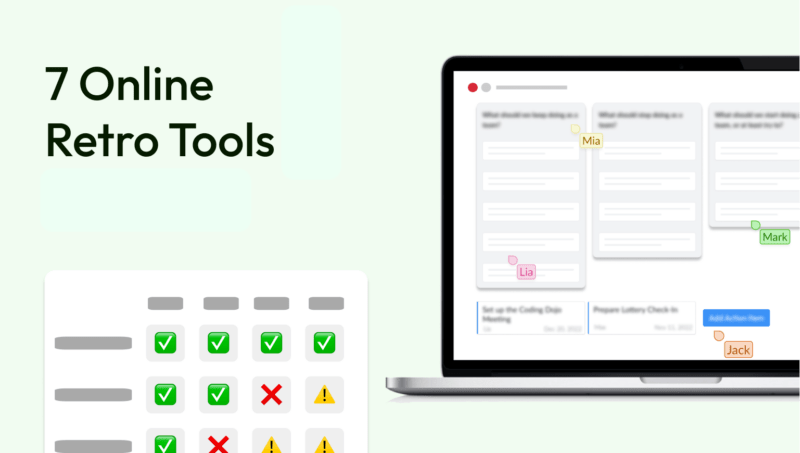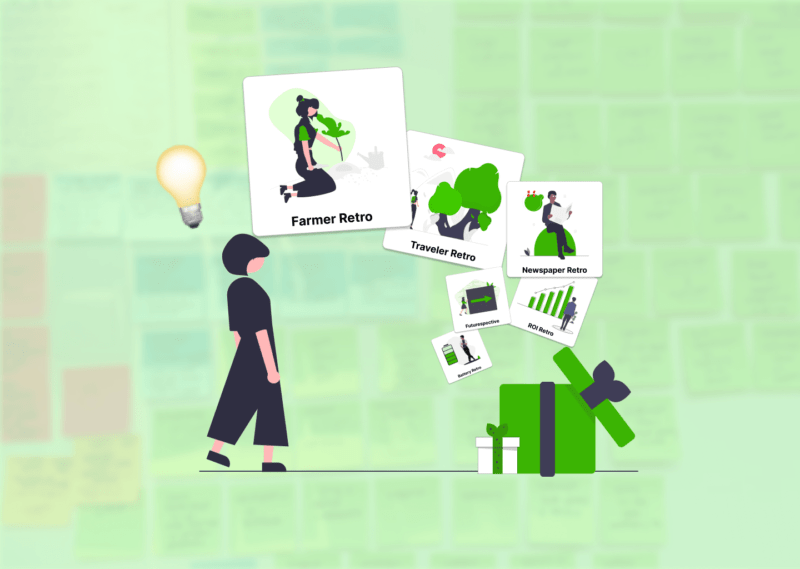Table of Contents
The power of a one-on-one meeting agenda
In today's workplace, continuous communication between managers and their team members is more important than ever. Weekly or bi-weekly one-on-one meetings have proven to be an effective way to maintain alignment and promote growth and productivity. No wonder 94% of managers hold one-on-one meetings and approximately 48% of those on a weekly basis.
In this article, you will learn how to create an effective one-on-one agenda and which templates are best suited to different situations.
Weekly One-on-One Meeting Agenda Template
Why you should hold (bi-)weekly one-on-one meetings 💡
The frequency of your one-on-one meetings can have a significant impact on their effectiveness. Regular meetings usually make it possible to stay close to the team.
But there are also certain differences between weekly and bi-weekly meetings. Weekly one-on-one meetings allow for quick adjustments and timely feedback, while bi-weekly one-on-one meetings allow more time for progress and changes between meetings.
It is therefore important that you are clear about the exact goal when planning the one-on-one meetings. Of course, you should also take the opinions of the team members into account.
Take your team's workflows, project cycles and individual preferences into account when determining the frequency. Basically, regardless of the interval you choose, consistency is the key to success!
The balance between quality and quantity
- Weekly one-on-one meetings: Ideal for fast-paced environments or when working on critical projects
- Bi-weekly one-on-one meetings: Suitable for more established teams or when more in-depth discussions are required.
By the way, if you're getting impatient with the agenda: My following video gives you a great one-to-one meeting agenda template, including 7 clever questions.
Weekly One-on-One Meeting Agenda Template
The ideal agenda for (bi-)weekly one-on-one meetings💡
An effective one-on-one meeting agenda ensures that these meetings are productive and valuable for both sides. To give you a concrete example: The following agenda asks the most important questions.
By the way, you can run the template interactively with Echometer, our psychologically sound 1-to-1 meeting software. It offers you many more question templates and even tips for taking action:
👋 Welcome & Icebreaker
- How are you today, how has your week been so far?
📕 Topics Employee [name]
- ...
👈 Manager topics: Review
- What went well last week?
- What were the challenges?
👈 Manager topics: Priorities & Goals
- What are your main priorities for the coming week?
- Where do you need my support?
🤚 Conclusion
- Is there anything else you would like to discuss?
⁉️ Mood check (survey)
Now you should already have a good feeling for a typical, good 1-on-1 meeting agenda. To go deeper, let's take a look at how we structure one-on-ones into individual phases.
Phase 1: Perfect preparation – How to organize productive one-on-one meetings
In the first phase (possibly before the meeting), both the manager and the employee contribute talking points:
- Use a shared document or tool where both parties can receive reminders and add topics you want to discuss (see e.g. example Echometer).
- Encourage your team members to take responsibility by adding their points to the 1:1 agenda before the 1:1 meeting.
- You can then add additional points if required.
This process ensures that the one-on-one meetings are co-designed by the employee, which increases engagement as the focus is on the employee.
You should then review the notes from the last one-on-one meeting:
- Before the current meeting, both parties should review the actions and discussions from the last meeting. This helps to track commitments and monitor progress over time.
Now, before you delve into the one-on-one conversation, it's time to organize things and determine the most important topics for discussion:
- Prioritize the most important or time-critical topics.
- Example: Current blockers or upcoming deadlines
- Ensure a mix of short-term tactical issues and longer-term strategic discussions.
- Example: Processes in the current project (tactical) and expansion of own strengths (strategic)
Phase 2: Effective conversations – How to get the most out of the meeting
Before getting down to serious business in the actual meeting, you can start with a short personal check-in, also known as an icebreaker:
- Start with a short, informal conversation to create a good atmosphere.
- Examples:
- How has your day been so far?
- What was your biggest success this week?
- What have you been working on the most over the past week?
- Examples:
- Limit this to 2-3 minutes to set a positive mood without unnecessarily prolonging the meeting.
After the icebreaker, it is now time to deal with the important issues. A sensible prioritization ensures that critical topics receive the necessary attention, even if time is short:
- Deal with the topics with the highest priority first when both participants are still focused.
- Examples:
- What is currently slowing you down at work?
- How is the project, which is due to be completed next week, going?
- Examples:
Since one-on-one meetings are not only about day-to-day tasks, but also about the employee's long-term satisfaction and development, it is important to balance tactical and strategic discussions:
- Tactical: Immediate tasks, current projects and short-term goals.
- Strategic: Long-term career development, thinking big and planning for the future.
- Aim for a split of around 70/30 between tactical and strategic topics in most one-on-one meetings.
Phase 3: Ensure sustainability – How to implement the results of the meeting
Now it is time to conclude the meeting. First, summarize the measures and decisions:
- Clearly list all actions taken during the meeting.
- Indicate who is responsible for which measure and by when it should be completed.
Finally, you should share the notes and next steps with your employee.
- Send a short summary of the meeting to the employee (e.g. via e-mail).
- Add the most important discussion points, decisions made and measures taken.
This creates a joint record that ensures that everyone involved is in agreement about what has been discussed.
By sticking to this agenda, you create a consistent framework for one-on-one meetings while maintaining the flexibility to address the most relevant topics each week.
"I like this employee, but he's underperforming. How can I address this in 1:1s?"
"I often don't know whether I was too hard – or too soft – in my 1:1s to make a positive impact."
"I can’t identify patterns or trends across my 1:1s. Everything feels isolated."
Weekly One-on-One Meeting Agenda Template
Measuring the influence of (bi-)weekly one-on-ones💡
To ensure that your one-on-ones are truly effective, it is important to measure their impact. This not only helps to improve the process, but also shows the value of these meetings for the employee and management.
Suitable KPIs (key performance indicators) for one-on-ones
- Employee commitment: Regular one-on-ones should lead to higher employee satisfaction and engagement. Use periodic surveys such as health check surveys to track this.
- Target achievement rate: Monitor how effectively employees achieve their goals discussed in one-on-ones.
- Employee retention: Over time, effective one-on-ones should contribute to higher employee retention rates and thus reduce turnover in the team.
Direct one-on-one feedback:
- ROTI (Return On Time Invested): After each one-on-one, ask for brief feedback on the effectiveness of the meeting. Our personal favorite is to ask for a ROTI score on a scale of 1-10 (How good was the time invested in this one-on-one meeting?). Here you can even compare the ROTI scores between the different meetings over time.
- Quarterly reviews: Conduct more in-depth reviews of the one-on-one process every few months.
With these KPIs, you are in the best position to demonstrate the effectiveness of one-on-one meetings to yourself, your employees and management.
Weekly One-on-One Meeting Agenda Template
Common pitfalls with one-on-ones and how to avoid them💡
Even with the best intentions, you can fall into certain traps when doing one-on-ones. Here are some common pitfalls and strategies to avoid them:
Turn one-on-ones into status reports:
- Pitfall: The meeting becomes a simple list of completed tasks.
- Solution: Focus on future-oriented discussions. Ask about challenges, resources needed and upcoming priorities rather than just discussing what has been done.
Neglecting long-term goals in favor of short-term issues:
- Pitfall: Each meeting focuses exclusively on immediate tasks and problems.
- Solution: Regularly discuss long-term career goals and development plans. Reserve time in each meeting for short and long-term topics.
Remember that: A good balance between tactical and strategic discussions is a 70/30 split.
Failure to follow up on measures:
- Pitfall: Commitments made in one-on-ones are forgotten or ignored.
- Solution: End each meeting by clearly naming and noting measures. Start the next meeting by reviewing these actions. Use a shared document or tool (such as Echometer) to track commitments over time.

Weekly One-on-One Meeting Agenda Template
Templates for different types of one-on-ones
Although a consistent structure is important, you can adapt to different situations by using different question formats within the main structure. Here are some templates you can use or adapt:
Examples of typical one-on-one questions
General questions:
- What's on your mind this week?
- What are your priorities for this week?
- How confident do you feel about the company's direction?
Strategy & progress:
- Do you have any questions about the strategy?
- Do you need input from me?
- How are you progressing with your goals?
- What have you learned since we last spoke?
- What has challenged you since we last spoke?
- What has gone well since we last spoke?
- What feedback do you have for me?
- Are there any interactions you would like to discuss?
Frequently occurring problems
Even though the above questions are good general questions, we have found in talking to numerous managers and team leaders that there are challenges where the "normal" questions don't work so well.
In short, we've identified six common people management problems that great one-on-one meeting agendas should help with:
These problems are:
- Customer empathy: "My employees have difficulty understanding the perspective of the customer and the company."
- Relationship building: "My employees don't open up to me in 1:1 meetings."
- Personal development: "My employees have no intrinsic development goals."
- Individual performance: "My employees are not optimizing their feedback loops and work processes."
- Soft skills: "My employees have difficulty expressing their doubts respectfully and productively" or "They feel easily attacked when they are criticized."
- Responsibility and participation in the team: "My employees do not take responsibility for our team goal."
As someone who conducts one-on-ones with their team members, you've probably experienced some of these issues yourself. That's why we at Echometer have developed special templates with psychologists and (agile) meeting experts to address them.
Sample templates for solving these problems
As we have already created more than 25 templates that address the problems mentioned above, I would like to present two examples here:
Problem Example #1:
"My employees have no intrinsic development goals."
Even though people may not have specific development goals, there are certainly aspects of their work that interest them more than others. If you look at the problem in this way, you can derive development goals from the interests that also motivate the employee. This is also known as "job crafting".
One-on-One Meeting Template: Job Crafting
We all have certain aspects of our work that we like more than others. There is usually some leeway to craft our roles according to our preferences. It's good to be aware of these preferences and communicate them to be prepared when job crafting opportunities arise. Questions for a "job crafting" 1:1 template:
👍 What aspects of your work do you like the most?
👎 Which aspects of your work do you like the least?
👇If you could delegate one of your tasks to someone else, what would it be?
🫴 If you could add one responsibility or decision-making power to your role, what would it be?
Problem Example #2:
"My employees have difficulty expressing their doubts."
or
"They feel easily attacked when they are criticized."
Many other problems often arise from this fundamental problem. One example of this is that these people often find it more difficult to set clear boundaries, which in turn reflects badly on these employees.
For this specific example, we've created a template called "Saying 'No'" that you can use in a one-on-one conversation with your employee:
One-on-One Meeting Template: Saying 'No'
If someone has difficulty saying "no", they may be given more and more tasks until they are at risk of burning out. This format helps individuals think about how to set appropriate expectations and say "no" when they need to.
🧠 Reflect: What are good reasons to say "no" when someone asks you to do something?
🤔 Collect examples: When was the last time you said "no" when someone asked you to do something? In which situations would you have liked to say "no" but didn't?
🧰 Tools: What phrases or questions can be helpful when someone wants you to do something?
Weekly One-on-One Meeting Agenda Template
Conclusion – Weekly One-on-One Meeting Agenda⚡
Regular one-on-one meetings, whether weekly or bi-weekly, are an excellent way to foster communication, improve performance and support employees. By creating a structured but flexible agenda, thorough preparation and consistent follow-up, you can maximize the impact of these important meetings.
Key factors for successful one-to-one meetings:
- Regularity: Stick to the agreed schedule, be it weekly or bi-weekly.
- Quality of the conversations: Focus on open and honest communication to discuss both short-term and long-term issues.
- Consistent tracking: Ensure that discussed tasks and goals are consistently pursued and implemented.
Short checklist for effective (bi-)weekly one-on-one meetings:
- Preparation:
- Use shared agenda documents
- Encourage employees to create an agenda
- Check previous notes and action items
- During the meeting:
- Personal check-in at the start
- Deal with the most important topics first
- Balance between tactical and strategic discussions (70/30)
- Follow-up:
- Summarize action items and decisions
- Share notes and next steps
Use the templates and strategies presented in this article as a starting point and adapt them to the needs and culture of your team. In addition, use meaningful KPIs to measure the success of the one-on-one meetings:
Meaningful KPIs:
- Employee commitment
- Target achievement rate
- Employee retention
- ROTI (Return On Time Invested)
- Quarterly feedback
With time and attention, one-on-one meetings will become a cornerstone of your management approach and drive success for your entire team.
If you are looking for a tool to help you prepare 1:1 meetings and select suitable templates, you can now try Echometer for free: Echometer Create workspace.
"I like this employee, but he's underperforming. How can I address this in 1:1s?"
"I often don't know whether I was too hard – or too soft – in my 1:1s to make a positive impact."
"I can’t identify patterns or trends across my 1:1s. Everything feels isolated."









